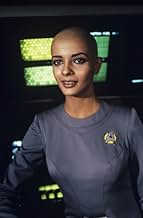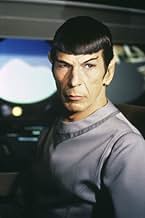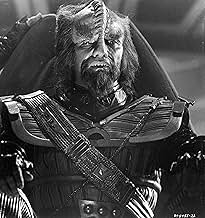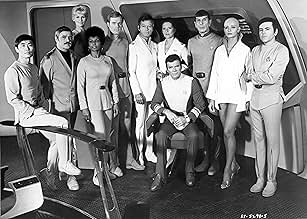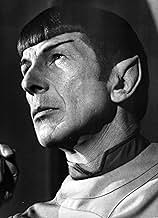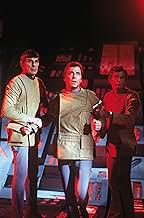Quando un veicolo spaziale alieno di enorme potenza viene osservato avvicinandosi alla Terra, l'ammiraglio James T. Kirk riprende il comando della USS Enterprise per intercettarlo.Quando un veicolo spaziale alieno di enorme potenza viene osservato avvicinandosi alla Terra, l'ammiraglio James T. Kirk riprende il comando della USS Enterprise per intercettarlo.Quando un veicolo spaziale alieno di enorme potenza viene osservato avvicinandosi alla Terra, l'ammiraglio James T. Kirk riprende il comando della USS Enterprise per intercettarlo.
- Regia
- Sceneggiatura
- Star
- Candidato a 3 Oscar
- 4 vittorie e 20 candidature totali
John Gowans
- Assistant to Rand
- (as John D. Gowans)
Recensioni in evidenza
Star Trek: The Motion Picture has its unique place in cinema history as probably the first television series to get a big screen motion picture. Completely due to its special fan base, the like of which has never been seen before or since.
In order to keep the phenomenon going Gene Roddenberry knew he had to have something special to offer and he did. The continuity from the television series was accomplished effortlessly, in fact one of the new characters Commander William Decker is the son of William Windom who was another starship captain in an episode. More I can't say less I give the plot away.
In fact Decker played by Stephen Collins would be commanding the newly fitted Enterprise if it were on a routine mission. But with the threat of an immense alien being on a direct path to earth now Admiral James T. Kirk takes command of the starship himself and with Decker reunites all the old crew from the TV series to meet the threat.
Fans of the original series will also see the similarities in plot between another episode involving the Enterprise meeting up with an old space probe that now has taken on some new functions. The same idea forms the basis of this film's story although in every way it has been expanded and a new ending conceived. Here's a hint, a budding relationship between Collins and new ship's lieutenant Persis Khambatta is what ultimately saves the earth.
Just as you remember them William Shatner, DeForest Kelley, Leonard Nimoy, James Doohan, Nichelle Nichols, George Takei, and Walter Koenig are all back and completely in character as you remember them. The new people Collins, Khambatta and the rest are integrated nicely into the story.
Star Trek: The Motion Picture received three Academy Award nominations, for Best Art&Set Direction, Best Visual Effects, and Best Musical Score. The special effects never overwhelm the telling of a good story which is the primary mission and best asset of the original television series and its successors.
If you're not a Trekkie before seeing this film, you may be come one upon viewing.
In order to keep the phenomenon going Gene Roddenberry knew he had to have something special to offer and he did. The continuity from the television series was accomplished effortlessly, in fact one of the new characters Commander William Decker is the son of William Windom who was another starship captain in an episode. More I can't say less I give the plot away.
In fact Decker played by Stephen Collins would be commanding the newly fitted Enterprise if it were on a routine mission. But with the threat of an immense alien being on a direct path to earth now Admiral James T. Kirk takes command of the starship himself and with Decker reunites all the old crew from the TV series to meet the threat.
Fans of the original series will also see the similarities in plot between another episode involving the Enterprise meeting up with an old space probe that now has taken on some new functions. The same idea forms the basis of this film's story although in every way it has been expanded and a new ending conceived. Here's a hint, a budding relationship between Collins and new ship's lieutenant Persis Khambatta is what ultimately saves the earth.
Just as you remember them William Shatner, DeForest Kelley, Leonard Nimoy, James Doohan, Nichelle Nichols, George Takei, and Walter Koenig are all back and completely in character as you remember them. The new people Collins, Khambatta and the rest are integrated nicely into the story.
Star Trek: The Motion Picture received three Academy Award nominations, for Best Art&Set Direction, Best Visual Effects, and Best Musical Score. The special effects never overwhelm the telling of a good story which is the primary mission and best asset of the original television series and its successors.
If you're not a Trekkie before seeing this film, you may be come one upon viewing.
This one starts really slowly but things pickup after that and become really interesting. Even with its weird pace it brings interesting scifi thoughts that are still valid today, probably even more. All in all, a good first motion picture for the series.
Of course the number one most memorable thing about The Motion Picture is the visual effects. The movie manages to show (for long sequences of time) how good the film looks with its budget and it is just incredible to watch. It also helps with the soundtrack being as good as it is. However, although the film has a beautiful look and a great soundtrack, the essential film itself does tend to drag. There are long (and I mean long) periods of time where nothing is happening. It seems like the director and writer were going for a different feel then the normal Star Trek feel. So overall while it does drag, Star Trek The Motion Picture still has some enjoyment to it.
Star Trek: The Motion Picture was Paramount Studio's attempt at cashing in on the Star Wars craze that was sweeping through the late seventies. However, instead of getting a fast-paced action romp, they got something more in tune with 2001: A Space Odyssey. Therefore, the first big screen Star Trek outing was always left in Star Wars' shadow. This, of course, was slightly rectified by the sequel (and darker and more action-orientated) The Wrath of Khan, but that's another story.
It's easy to see why Star Trek: The Motion Picture never set the box office alight, it's slow, very talky-talky, with lingering shots of things that you don't really know what they are and absolutely no action. However, that said, it's actually quite good (but only if you're in the mood).
If you're looking for something fast-paced then you should probably ignore most of the Star Trek saga and skip straight to the 2009 reboot. Whereas if you are a fan of slow-burning (and dare I say it?) 'intellectual' science fiction then you might get something out of this.
Avatar it is not. Interesting it is. Although, it should probably have an 'Eighteen Certificate' slapped on it - not because the content is particularly 'adult' in nature, but simply because there's no way anyone under eighteen would ever appreciate it and have the patience to sit through it.
May the old crew live long and prosper.
It's easy to see why Star Trek: The Motion Picture never set the box office alight, it's slow, very talky-talky, with lingering shots of things that you don't really know what they are and absolutely no action. However, that said, it's actually quite good (but only if you're in the mood).
If you're looking for something fast-paced then you should probably ignore most of the Star Trek saga and skip straight to the 2009 reboot. Whereas if you are a fan of slow-burning (and dare I say it?) 'intellectual' science fiction then you might get something out of this.
Avatar it is not. Interesting it is. Although, it should probably have an 'Eighteen Certificate' slapped on it - not because the content is particularly 'adult' in nature, but simply because there's no way anyone under eighteen would ever appreciate it and have the patience to sit through it.
May the old crew live long and prosper.
Star Trek: The Motion Picture - Stardate: 7412.6
Of all the Star Trek films, this is the most impersonal and epic - which necessarily isn't a bad thing. This film really isn't about the Star Trek crew, but about the vast visual effects laden V'Ger and how the Enterprise spends 2+ hours exploring it. The score by Jerry Goldsmith only accentuates this epic-ness - this is one of his best scores and brings a majestic quality to the Star Trek crew. Never really is this film funny (unlike 4) or action-packed (unlike II) but regardless will always have a place in my heart because it tries to be as epic as Star Trek can possibly be. Overall, a 7 out of 10 (mostly because of the state-of-the-art effects of its time in 1979 and a superb score by Jerry Goldsmith RIP).
Of all the Star Trek films, this is the most impersonal and epic - which necessarily isn't a bad thing. This film really isn't about the Star Trek crew, but about the vast visual effects laden V'Ger and how the Enterprise spends 2+ hours exploring it. The score by Jerry Goldsmith only accentuates this epic-ness - this is one of his best scores and brings a majestic quality to the Star Trek crew. Never really is this film funny (unlike 4) or action-packed (unlike II) but regardless will always have a place in my heart because it tries to be as epic as Star Trek can possibly be. Overall, a 7 out of 10 (mostly because of the state-of-the-art effects of its time in 1979 and a superb score by Jerry Goldsmith RIP).
Lo sapevi?
- QuizWhen Captain Kirk addresses the crew before launching, many of the extras were noted Star Trek fans, including Bjo Trimble, co-organizer of the letter-writing campaign that kept Star Trek (1966) alive for a third season.
- BlooperWhen flying past Jupiter, three consecutive shots of Jupiter and its moons are shown. The first and third are from the POV of the ship as it approaches and passes Jupiter, and show the sunshine on planet and several moons coming from the port aft. The second shot shows the opposite angle of the oncoming ship, and the sunshine on the planet and 4 moons is coming from a different direction on each body, none of them from the port aft.
- Curiosità sui creditiEnd title: "The human adventure is just beginning."
- Versioni alternativeOn November 6, 2001, the Director's Edition supervised by Robert Wise was released on DVD and widescreen VHS, running 136 minutes. The material added to the film consists of the following:
- The landscape of Vulcan was changed to include a yellowish sky and new landscape featuring massive statues. All other footage was tinted gold.
- The matte painting of the Golden Gate Bridge in the scene where Kirk arrives at Starfleet Headquarters was replaced by a new CGI scene that shows Kirk's shuttle arriving at Starfleet. It is actually slightly longer than the original version.
- The matte painting of Starfleet Command was improved with CGI effects, including an original series shuttle launched in the background.
- In a close-up shot when Kirk first sees the new Enterprise from his shuttle, the image of the ship was superimposed over Kirk's face as a reflection in the shuttle's window.
- After Kirk leaves the bridge, a short conversation between Sulu, Uhura and an alien officer was inserted.**
- A new CGI shot of the Earth is shown on the viewscreen when the Enterprise leaves the planet.
- A new CGI effect showing one of the Enterprise's nacelles was inserted into the window when Kirk, Spock and McCoy speak on the observation deck.
- A new CGI shot was inserted which shows V'Ger's second energy torpedo vanishing before it could strike the Enterprise.
- The energy probe that invades the bridge now approaches in a CGI exterior shot.
- A new CGI shot shows the V'Ger vessel entering Earth orbit.
- The scene in which Chekov burns his hand is much longer and shows Lt. Ilia healing him with her empathic powers instead of Nurse Chapel.**
- The long walk to V'Ger was totally redone. There is now a walkway that materializes out of thin air, compared to the endless field in the original version.
- The Enterprise's voyage to the center of V'Ger is slightly extended. It has a scene of Spock sharing a tear "for V'Ger" and Scotty ordered to self-destruct the ship if the landing party is unsuccessful.**
- The small black "empty matte" in the window when Decker and Ilia confront each other in the recreation deck was replaced with a CGI shot of the V'Ger cloud interior.
- The final explosion of V'Ger was slightly extended. The shot from the original version remained intact, but a new element of the vessel imploding its energy for the explosion was added.
- New opening titles were commissioned for the film's opening. The opening titles now have a slight fading effect and are now seen over a background of stars. The text is colored a bright gold, compared to the original version's white.
- The explosion in the wormhole was redone. There is now an exterior shot of the asteroid exploding and the wormhole disintegrating. Additionally, the viewfinder in the next shot is enhanced to show sparks and debris.
- The final message to the audience, "The human adventure is just beginning", was altered. In the original version, the starfield cuts away to a blank title card showing the text. In the Director's Edition, the starfield was extended by a few seconds to allow the text, colored bright gold, to fade into the picture.
- The ending credits were slightly altered. The text, as with the opening titles and the final "human adventure" text, was changed color, from white to a bright gold. Additionally, the music was slightly extended to add new Director's Edition credits.
- An all-new sound mix was commissioned, keeping the music and dialog intact, and adding new effects for almost all scenes. For example, the Enterprise computer voice alarms are now replaced with klaxon sirens, the lightning effects have new echoes, and a blend of Enterprise bridge sound effects from the original Star Trek series, Star Trek II: The Wrath of Khan, and Star Trek VI: The Undiscovered Country have been added into the background of scenes taking place on the bridge. The new mix is in Dolby 5.1 EX Surround.
- The footage from 1979 was digitally restored and remastered, and combined with the new CGI elements.
- The opening overture has been restored to its full length. It is also played over a CGI starfield, rather than the blank screen in the original version.
- A slight dialog alteration was made: In the 1979 and 1983 versions, the V'Ger cloud is said to be "over 82 AUs in diameter" which equals 7.626 billion miles across - much too large for the Enterprise to realistically travel to the heart of the cloud at subwarp speeds within a reasonable length of time. For the Director's Edition, the Epsilon 9 commander's dialog was altered so that the cloud is now said to be a (somewhat) more reasonable "over 2 AUs", or 186 million miles.
- The producers of the Director's Edition submitted the film for re-rating by the MPAA, hoping for a PG rating rather than the original G rating which they believed carried a negative association; the basis for the higher rating was the intensified soundtrack. Oddly, when the original theatrical version was released on DVD and Blu-ray in 2009, it carried no MPAA rating.
- Scenes previously available in the "special longer version."
- ConnessioniEdited into Star Trek II - L'ira di Khan (1982)
- Colonne sonoreTheme from 'Star Trek: The television Series'
Written by Alexander Courage and Gene Roddenberry
I più visti
Accedi per valutare e creare un elenco di titoli salvati per ottenere consigli personalizzati
Dettagli
- Data di uscita
- Paese di origine
- Sito ufficiale
- Lingue
- Celebre anche come
- Star Trek - The Motion Picture
- Luoghi delle riprese
- Yellowstone National Park, Wyoming, Stati Uniti(portions of planet Vulcan sequence filmed at Minerva Terrace)
- Aziende produttrici
- Vedi altri crediti dell’azienda su IMDbPro
Botteghino
- Budget
- 35.000.000 USD (previsto)
- Lordo Stati Uniti e Canada
- 82.604.699 USD
- Fine settimana di apertura Stati Uniti e Canada
- 11.926.421 USD
- 9 dic 1979
- Lordo in tutto il mondo
- 82.676.805 USD
- Tempo di esecuzione
- 2h 23min(143 min)
- Colore
- Mix di suoni
- Proporzioni
- 2.39 : 1
Contribuisci a questa pagina
Suggerisci una modifica o aggiungi i contenuti mancanti




